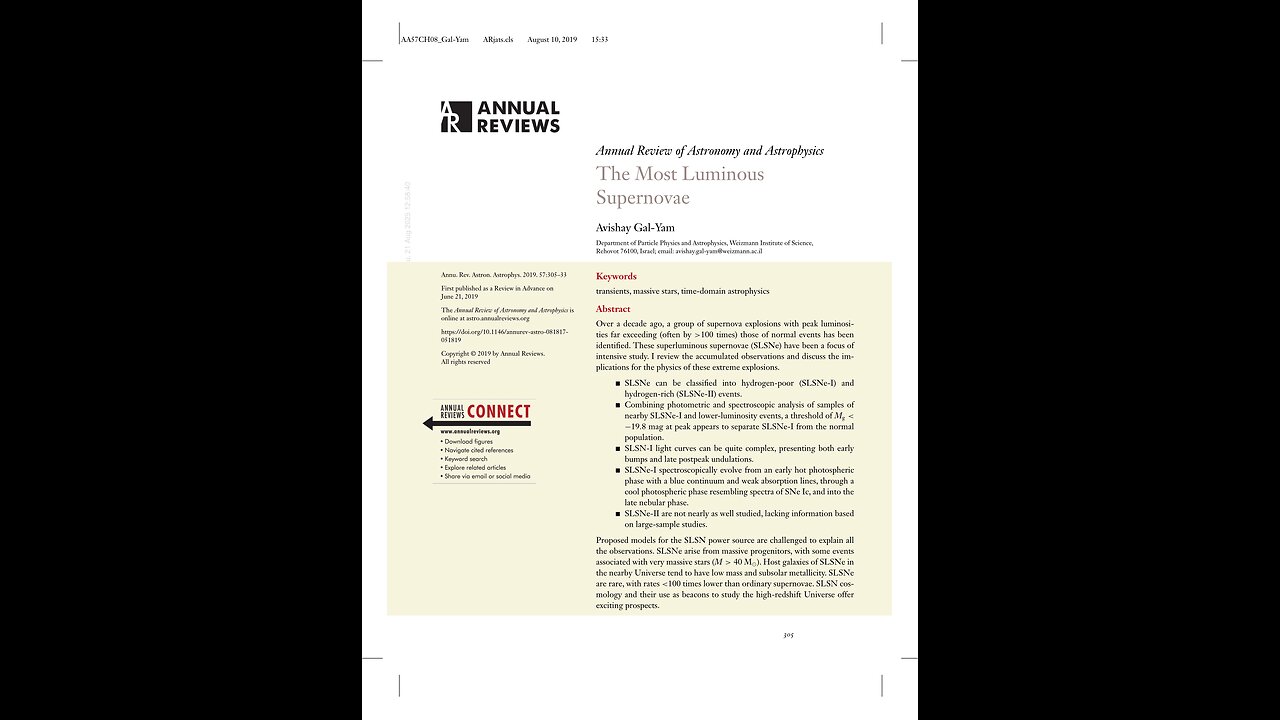Premium Only Content

The Most Luminous Supernovae, 2019. A Puke(TM) Audiopaper
Index of Other Science Articles:
https://rumble.com/v3t4yzj-index-of-science.-music-by-dan-vasc.html
Annual Review of Astronomy and Astrophysics.
The Most Luminous Supernovae.
Avishay Gal-Yam, Department of Particle Physics and Astrophysics, Weizmann Institute of Science, Israel.
Annu. Rev. Astron. Astrophys. 2019. 57:305–33
https://www.annualreviews.org/content/journals/10.1146/annurev-astro-081817-051819
Keywords. Transients, massive stars, time-domain astrophysics.
Abstract.
Over a decade ago, a group of supernova explosions with peak luminosities far exceeding (often by greater than 100 times) those of normal events has been identified. These super-luminous supernovae, S L S N e, have been a focus of intensive study. I review the accumulated observations and discuss the implications for the physics of these extreme explosions. Super-luminous supernovae can be classified into hydrogen-poor (S L Super Novae type One) and hydrogen-rich (S L Super Novae Two) events. Combining photometric and spectroscopic analysis of samples of nearby Hydrogen-poor super-luminous supernovae and lower-luminosity events, a threshold of M g less than minus 19.8 mag at peak appears to separate Hydrogen-poor super-luminous supernovae from the normal population. Super-luminous supernovae One light curves can be quite complex, presenting both early bumps and late postpeak undulations. Hydrogen-poor super-luminous supernovae spectroscopically evolve from an early hot photospheric phase with a blue continuum and weak absorption lines, through a cool photospheric phase resembling spectra of Supernovae One c, and into the late nebular phase. Hydrogen-rich super-luminous supernovae are not nearly as well studied, lacking information based on large-sample studies.
Proposed models for the SUPER-LUMINOUS SUPERNOVAE power source are challenged to explain all the observations. Super-luminous supernovae arise from massive progenitors, with some events associated with very massive stars, with Mass greater than 40 Solar Masses. Host galaxies of Super-luminous supernovae in the nearby Universe tend to have low mass and subsolar metallicity. Super-luminous supernovae are rare, with rates less than 100 times lower than ordinary supernovae. SUPER-LUMINOUS SUPERNOVAE cosmology and their use as beacons to study the high-redshift Universe offer exciting prospects.
One. INTRODUCTION: A BRIEF HISTORICAL REVIEW.
The luminosity of supernovae (S N e) was the defining feature of these remarkable stellar events and set these apart from less luminous and much more common stellar eruptions such as classical novae. Observed supernova populations are invariably dominated by Type one “A” events, which are the most luminous of all common Supernovae. Analyzing the statistics of peak supernova luminosities, Richardson et al noted in two thousand and two, a population of rare, overluminous events that are significantly more luminous than Supernovae One “A”, Luminosity greater than 1.2 times 10 to the 43 erg per second M less than minus 19.5 magnitudes.
Taking Log to base 10 of Luminosity over 4 pi, this is approximately 10 to the 35 watts per steradian, or about ten orders of magnitude greater than a typical G type dwarf.
Following the discovery and detailed studies of a few nearby superluminous events, this population has become a focus of intense study. In particular, Quimby et al in 20 11, used observations across a range of redshift in order to unify several fragmented reports and define a spectroscopic class of hydrogen-poor superluminous events. Gal-Yam in 20 12 reviewed extant observation, provided a detailed historical review, set a fiducial threshold to consider an event as a super-luminous supernova (SLSN), and introduced the subclasses of hydrogen-poor (SLSN-one) and hydrogen-rich (SLSN-two) events. More recently, this class of objects was reviewed by Howell and by Gal-Yam in 20 17 in the context of SN classification, whereas Moriya et al in 20 18 provide a broad theoretical perspective.
The goal of this review is to update and expand on the work of Gal-Yam in 20 12, using a substantially larger data set collected since, 115 Super-luminous supernovae are currently listed on WISe REP, a sample greater than5 times larger than the 18 events available for analysis in 20 12.
Section Two. DEFINING THE CLASS OF SUPERLUMINOUS SUPERNOVAE.
2 point 1. Luminosity Threshold.
Super-luminous supernovae are by definition more luminous than normal events, with individual events being as luminous as L bolometric greater than 3 times 10 to the 44 ergs per second. In 20 12 Gal-Yam set an arbitrary fiducial luminosity threshold of L greater than 7 times 10 to the 43 ergs per second, an absolute magnitude M less than minus 21 magnitudes, in any band to consider an object as super-luminous. The drawbacks of this choice, beyond its arbitrary nature, are obvious and include ambiguity due to the selected observing bands, color effects, and K-corrections that are significant for Super-luminous supernovae at high redshifts. Additional ambiguity involves the event timescale. In this review, we focus on events that maintain their peak luminosity over a minimal timescale of greater than 48 hours. This excludes shorter, luminous flares that can reach greater than 10 to the 44 ergs per second, such as those associated with SN explosion shocks and gamma ray burst afterglow emission that is associated with some broad-line Supernovae One c (Supernovae One c-BL). We also exclude events with a peak luminosity that is within the range of standard events but that are exceptionally long lived such that they can reach a high integrated luminosity over several years.
In 20 18 De Cia et al inspected a large sample of Type One, hydrogen-poor, Super-luminous supernovae, as well as normal and Supernovae One c-BL from the Palomar Transient Factory, PTF, survey in order to test whether a natural luminosity threshold emerges from the data, for example a double-peaked luminosity distribution of normal and super-luminous events. However, after correcting for the much larger volume probed by the PTF survey for Super-luminous supernovae, the luminosity distributions of SLSN e One, Supernovae One c, and Supernovae One c-BL seem to join smoothly into a single distribution. Current observations therefore do not support a natural luminosity threshold separating Hydrogen-poor super-luminous supernovae from lower luminosity Supernovae One c. Inserra et al in 20 18 conducted a more sophisticated analysis of the photometric properties of Hydrogen-poor super-luminous supernovae and propose a set of four photometric parameters, the peak magnitude at rest frame 400 nano meters, the magnitude decline in this band within 30 rest frame days from peak, and the 400 nano meters to 520 nano meters color at peak and at 30 days after, that can be used to statistically select Hydrogen-poor super-luminous supernovae without a luminosity threshold. Although this method could be used to select Hydrogen-poor super-luminous supernovae from large samples of events, it has several limitations: It does not apply to all Hydrogen-poor super-luminous supernovae (for example, those with double peaked light curves, it is only 90 percent complete even within the restricted event subsample presented by Inserra et al in 20 18, it requires multiband photometric coverage during and after peak, and its selection purity, number of false SUPER-LUMINOUS SUPERNOVAE identifications, has not been robustly estimated. It thus cannot be used as a definition of the SLSN-One class at this time.
Similar analysis is yet to be carried out for hydrogen-rich super-luminous supernovae. Although individual events exist that span the range greater than 5 magnitudes, of luminosities from normal events to the most luminous SLSN-Two, it is unclear whether the most luminous events are drawn from a luminosity distribution that smoothly extends to normal events.
2 point 2. Spectroscopic Definition.
Lacking a clear luminosity threshold, one may hope to find a spectroscopic definition for Super-luminous supernovae, meaning a set of spectroscopic features that are common to Super-luminous supernovae and differ from those of normal, lower-luminosity events.
Figure 1.
A histogram of the luminosity of Hydrogen-poor super-luminous supernovae, Supernovae One c, and Supernovae One c BL from the Palomar Transient Factory survey with a volumetric correction accounting for the detectability of more luminous events out to larger distances. The more luminous events (blue) also share spectral similarity according to Quimby et al in 20 18, suggesting a threshold of rest frame M g equal to minus 19.8 magnitudes at peak may separate Hydrogen-poor super-luminous supernovae from lower-luminosity events.
Abbreviations: SLSLN e, super-luminous supernovae, S N e, supernovae.
PS1-MDS: The Pan-STARRS1 Medium Deep Survey.
Quimby et al achieved this in 2018 for the hydrogen-poor (SLSN-One) variety. Applying an estimate for spectral similarity based on automated chi squared minimization ranking against spectral template libraries, these authors show that the most luminous events are also spectroscopically similar, and a threshold exists, M g equal to minus 19.8 magnitudes, that separates the more luminous events (Figure 1) and more common events with normal luminosity (see the sidebar titled A Photometric Threshold for Hydrogen-Poor Super-luminous Supernovae type one. As this threshold presumably separates two distributions of different object classes, one does not expect it to be sharp: Rare luminous “normal” Supernovae may have brighter peak magnitudes, as there could be some spectroscopic Hydrogen-poor super-luminous supernovae that fall below this threshold. Yet, at this time this value seems to offer a useful threshold. For example, the implied lower-luminosity threshold for Hydrogen-poor super-luminous supernovae includes all the events spectroscopically identified by Lunnan et al in 2018 as Hydrogen-poor super-luminous supernovae in their luminosity unbiased analysis of events from the Pan-STARRS1, the Panoramic Survey Telescope and Rapid Response System, Medium Deep Survey, PS1-MDS. At this time, no similar investigations have been conducted for SLSN e-Two.
A PHOTOMETRIC THRESHOLD FOR HYDROGEN-POOR SUPERLUMINOUS SUPERNOVAE One.
The combination of photometric and spectroscopic analysis of the PTF sample of Hydrogen-poor super-luminous supernovae suggests an absolute magnitude threshold of M g equal to minus 19.8 magnitudes, above which all Hydrogen and Helium poor events in this sample belong to a single spectroscopic similarity class that we identify as SLSN One.
2 point 3. Relationship to Normal Events.
Beyond the luminosity threshold, it is interesting to check whether other properties distinguish Super-luminous supernovae from lower-luminosity events.
2 point 3 point 1. Hydrogen-poor super-luminous supernovae type One.
Even though the volume-corrected luminosity distributions of Hydrogen-poor super-luminous supernovae, Supernovae One c, and Supernovae One c-BL join smoothly, several differences exist between these populations, suggesting that Super-luminous supernovae are not just the upper luminosity tail of Supernovae One c, as is also supported by spectroscopic analysis. De Cia et al pointed out in 20 18 that the rise time of Hydrogen-poor super-luminous supernovae is significantly longer compared to that of normal events with similar decay times, meaning, that the ratio of rise to decay time constitutes a photometric criterion to statistically separate these populations. In addition, as discussed below, early bumps prior to the first peak appear to be common in Hydrogen-poor super-luminous supernovae and are very rare in less luminous Supernovae One c. Finally, Perley et al in 20 16, and Schulze et al in 20 18, show that the fraction of Hydrogen-poor super-luminous supernovae from all Supernovae is strongly suppressed in typically high-mass galaxies with metallicity above Z equal to 0.4 to 0.5 Solar Metallicity, unlike normal Supernovae One c (but perhaps similar to Supernovae One c-BL.
2 point 3 point 2. Hydrogen-rich super-luminous supernovae Type Two.
Because there are very few studies, it is hard to determine whether and how Hydrogen-rich super-luminous supernovae are related to lower-luminosity Supernovae Type Two. Host galaxy properties do seem to suggest a distinction between Hydrogen-rich super-luminous supernovae and lower-luminosity Supernovae (Section 6).
SECTION THREE. CLASSIFICATION OF SUPERLUMINOUS SUPERNOVAE.
The classification scheme of Super-luminous supernovae follows that of lower-luminosity events and relies mainly on near-peak flux visible-light spectroscopy.
See the sidebar titled Summary of Superluminous Supernova Classification.
3 point 1. Super-luminous Supernovae One.
Figure 2 shows typical prepeak spectra of this class of hydrogen-poor SL Supernovae.
Spectra shown in this and all other figures are publicly available from WISe REP.
The strongest lines in visible-light spectra of Hydrogen-poor super-luminous supernovae arise from the cumulative absorption of a large number of dense Oxygen two transitions in the blue wavelengths lambda between 3 and 5 thousand Angstroms. In the Ultra-Violet there are several strong absorption features, whereas the red part of the spectrum shows typically much weaker features of Oxygen One and Carbon two. At later phases, weeks to months after peak, the spectrum evolves and becomes similar to that of more normal Supernovae One c around peak, Figure 3. Below, we refer to these two phases as the hot and cool photospheric phases, see Sections 4 point 2 point 1 and 4 point 2 point 2, respectively.
Spectroscopic classification of Hydrogen-poor super-luminous supernovae is thus usually done at or before peak on the basis of either the identification of the Oxygen two complex in low-redshift events, or the Ultra-Violet lines that are redshifted into the visible for higher-redshift Super-luminous supernovae (Figure 2).
SUMMARY OF SUPERLUMINOUS SUPERNOVA CLASSIFICATION.
Hydrogen-poor super-luminous supernovae lack strong features of hydrogen in peak-light spectra. Hydrogen-rich events include S L S N e two-n that show strong narrow emission lines of hydrogen, Hydrogen-rich super-luminous supernovae that show broad hydrogen absorption features, and a single S L S N two b that shows strong absorption features of both hydrogen and helium.
Figure 2.
Prepeak spectra of Hydrogen-poor super-luminous supernovae during the hot photospheric phase, Section 4 point 2 point 1. Combining visible-light observations of typical high redshift, z equal to 0.74, and low-redshift, z equal to 0.1075, events traces the near-Ultra-Violet and optical spectrum covering the SUPER-LUMINOUS SUPERNOVAE emission peak.
Weak lines of Oxygen One and Carbon two are detected redward of 5,000 angstroms. A dense forest of Oxygen two absorption features dominates the spectrum between 3,500 and 5,000 Angstroms, with the strongest features appearing around 4,200 Angstroms and 4,500 Angstroms, and several strong absorption features are seen in the Ultra-Violet below 3,200 Angstroms.
An illustration of the formation of the Oxygen two complex by a dense distribution of Oxygen two lines. Gaps in the distribution of Oxygen two transitions, blue, appear as emission peaks. The effective central wavelengths of the five main Oxygen two absorption features are plotted in black and match the data very well, all lines offset to account for an expansion velocity of 11,000 kilometers per second. Lines of all elements have been shifted by an expansion velocity of 11,000 kilometers per second. Abbreviation: SLSN(e), superluminous supernova(e).
Events lacking peak spectra can alternatively be classified by a combination of high peak luminosity and late-time similarity to Supernovae One c (Figure 3).
3 point 1 point 1. Proposed subdivisions.
Gal-Yam proposed in 20 12 a possible division among hydrogen poor Super-luminous supernovae into rapidly declining Hydrogen-poor super-luminous supernovae and slowly declining events (with a decay rate consistent with radioactive decay of Cobalt 56 designated SLSN-R. This division was not broadly adopted.
Recent sample studies fail to find a clear natural division into two distinct classes of rapidly and slowly declining hydrogen-poor events.
Figure 3.
Postpeak spectra of Hydrogen-poor super-luminous supernovae during the cool photospheric phase. Several weeks to months, for example, SN 20 15bn, after peak, Hydrogen-poor super-luminous supernovae evolve to resemble normal Supernovae One c around peak, SN two thousand and seven gr shown for comparison. Abbreviations:
SLSN, superluminous supernovae.
SN, supernova.
Inserra et al conducted in 20 18 a more sophisticated statistical analysis (including unsupervised clustering) of multiple photometric and spectroscopic parameters of Hydrogen-poor super-luminous supernovae, and claim that a restricted set of events does cluster into two groups defined by rapid or slow evolution. This interesting work is limited by small numbers, only three events cluster into the slow category. Inserra et al in 20 17 inspect the light-curve properties of slowly fading Hydrogen-poor super-luminous supernovae and propose that these may show ubiquitous postpeak undulations. Spectroscopic analysis conducted by Quimby et al in 20 18 also suggests a division based on similarity to two prototype events that are slowly and rapidly declining Hydrogen-poor super-luminous supernovae, respectively. A clear test of whether distinct groups of Hydrogen-poor super-luminous supernovae exist would greatly benefit from the large numbers of events expected from forthcoming massive surveys. Until that time, the term SLSN-One is applied to the entire class.
3 point 2. Super-luminous Supernovae type Two.
Hydrogen-rich super-luminous supernovae show clear spectroscopic signatures of hydrogen around peak. Helium features are often also seen, especially in early, hot events.
Figure 4.
Spectra of Hydrogen-rich super-luminous supernovae. SLSN e-Two n show strong Hydrogen Balmer emission lines over a blue continuum at early time (SN two thousand and eight “A-M”, evolving into a more complex spectrum after peak. Rare Hydrogen-rich super-luminous supernovae do not show narrow emission lines but rather blue continuum spectra, with broad Helium two in the case of SN two thousand and eight “E-S” shown, that evolve into broad absorption features of Hydrogen and Helium one after peak, empty markers have been blue shifted by 6,000 kilometers per second to match the observed absorption features. Abbreviations:
SLSN, super-luminous supernovae.
SN, supernova.
3 point 2 point 1. The narrow-line super-luminous supernovae Two-n class.
Most events (similar in numbers to Hydrogen-poor super-luminous supernovae, show prominent emission lines of the hydrogen Balmer series, often accompanied by Helium one, with a narrow core over a broader base (Figure 4), similar to lower-luminosity Supernovae Two-n. Initially some objects show a blue continuum with Balmer emission lines only, whereas more complex spectra develop later (Figure 4).
3 point 2 point 2. The super-luminous supernova Two class and its relationship to super-luminous supernovae One.
The first reported hydrogen-rich SUPER-LUMINOUS SUPERNOVAE that did not exhibit narrow Balmer lines was SN two thousand and eight “E-S”. The sample of similar events remains small and currently includes only a handful of additional events.
The group is characterized by spectra with evident Balmer lines in absorption or with P-Cygni profiles but lacking narrow Two-n like features, which is an important distinction as such narrow features are generally taken as evidence for strong circumstellar material, CSM, interaction. Spectra are typically featureless initially with lines developing with time and becoming strong postpeak.
Late spectra, in particular those studied by Benetti et al in 20 14, evolve to strongly resemble late SLSN-One spectra superposed with a weak Balmer series, suggesting a connection between these rare Hydrogen-rich super-luminous supernovae and the more common Hydrogen-poor super-luminous supernovae, perhaps driven by a small amount of residual hydrogen left in the outer stellar envelope when these Supernovae explode. PTF 10 “H G I” is currently a unique case of a SUPER-LUMINOUS SUPERNOVAE that was initially classified as an SLSN-one but actually shows clear spectral signatures of hydrogen and helium, motivating a classification of SLSN Two-b in analogy to lower-luminosity events. Interestingly, this event is also among the few that cannot be satisfactorily fit by a parameterized magnetar model by De Cia et al from 20 18 and is an outlier in the analysis by Nicholl et al of 20 15, having very slow photospheric velocities.
Section FOUR. OBSERVED PROPERTIES OF SUPERLUMINOUS SUPERNOVAE.
4 point 1. Photometry.
As a class, Super-luminous supernovae of both types one and two typically have longer timescales in both rise and fall from peak compared to most lower-luminosity events. Nearby events are often observable for many months with small telescopes and can be followed for years with more sensitive instruments.
4 point 1 point 1. Super-luminous supernovae type one.
Light curves of Hydrogen-poor super-luminous supernovae can be quite complex. The slow evolution both before and after peak is often accompanied by short-term undulations and bumps. Figure 5 shows the bolometric light curve of PTF 12 ”D A M”. This slowly declining SLSN-One was discovered shortly after explosions and followed extensively.
Figure 5.
(a) The bolometric light curve of PTF 12 ”D A M”, a well-observed slowly declining SLSN-One. The symbols are color-coded based on the temperature fits, values prior to minus 25 days, which are not coded, require extrapolations and are less certain. Main spectroscopic phases discussed below are marked for reference. PTF 12 ”D A M” transitioned from the hot to the cool photospheric phase about a month after peak and went into the nebular phase around 200 days postpeak. An early bump is detected shortly after explosion. Late (postpeak) bumps, often seen in slowly declining events, are not obvious in the bolometric light curve of this event. (b) A similar plot for the rapidly declining SLSN-One. This event has a prominent early bump, during which the temperature measured is significantly hotter than at peak. The decline from peak to the cool photospheric phase is rapid but not well measured, for such rapid decliners, nebular phase observations are challenging.
Abbreviation: SLSN, super-luminous supernova.
4 point 1 point 1 point 1. Typical light curves: Peak.
TSS, an abbreviation for the Texas Supernova Survey.
As explained in Section 2.1, when correcting for the larger volume within which more luminous events can be observed, Hydrogen-poor super-luminous supernovae do not seem to separate from normal Supernovae One b, c into a bimodal luminosity distribution, but hydrogen-poor Supernovae brighter than M g equal to minus 19.8 mag appear to belong to the spectroscopic class of SLSN e-One, the hydrogen-poor super-luminous supernovae. The range of peak magnitudes observed extends from this lower cutoff up to M g equal to minus 22.5 mag or so for the brightest events. The mean peak luminosity of observed hydrogen-poor super-luminous supernova samples somewhat depends on the survey properties. Using a relatively small sample based on the Texas Supernova Survey (TSS), find a typical peak magnitude of unfiltered magnitude equal to minus 21.7 plus or minus 0.4 magnitudes. Several literature compilation studies find similar values, including Nicholl and Smart, who derived M g equal to minus 21.62 plus or minus 0.59 mag (assuming M griz equal to M g minus 0.9 magnitudes, and Inserra, who measured M 400 nano-meter equal to minus 21.7 plus or minus 0.5 magnitudes.
Applying a volumetric correction, De Cia found in 20 18 a mean g-band absolute peak magnitude of M g equal to minus 21.14 plus or minus 0.75 mag for the PTF sample, whereas Lunnan et al in 20 18 measure M40 nm equal to minus21.1 plus or minus 0.7 mag from PS1. Transforming either observed or calculated rest frame magnitude distributions into luminosities depends on assumptions regarding SLSN-One K-corrections, but typical luminosity values range from 2.5 times 10 to the 43 to 5 times 10 to the 44 ergs per second.
Of note is ASA SSN-15 lh, a transient with a peak magnitude that stands out above even the most luminous Hydrogen-poor super-luminous supernovae, M around minus 23.5 magnitudes. However, the association of this transient with the class of Hydrogen-poor super-luminous supernovae has been challenged, and remains uncertain.
4 point 1 point 1 point 2. Typical light curves: Rise times.
Using the time difference between first detection and peak as a lower limit on the rise time, the SLSN-One samples include events with a bolometric rise time ranging from around 20 to greater than100 rest frame days, with PTF 10 nmn and PS 1-14 bj being examples of events having extremely long rise times from each sample, respectively. Even the fastest-rising events have longer bolometric rise times than those of normal hydrogen-poor type One Supernovae, less than20 days. Various quantitative measures of the rise time are provided in the literature. De Cia et al in 20 18 tabulate the time to rise by 1 mag or from half flux to peak in rest frame g-band, whereas Nicholl 20 15 and Lunnan 20 18 tabulate the bolometric time to rise from one over e below maximum to peak. Nicholl in 20 17 provide bolometric rise times estimated from light-curve models that are consistent with the values cited above.
4 point 1 point 1. Point 3. Typical light curves: Decay times and slopes.
SLSN-One decay times are typically slower than those of normal Supernovae Type One. Because Super-luminous supernovae are rarely (if ever) followed till their physical disappearance (meaning, when the SN is less luminous than its progenitor star), absolute decay times are not well defined. Various works tabulate decay slopes, ranging in restframe g-band from less than 0.01 to about 0.08 magnitudes per day, or times to decay by 1 magnitude or to half of peak flux or by one over e. Alternatively, measures of the light decay in a certain band in magnitudes within a given period in days, for example, delta M20, or delta M30, are provided in the literature.
4 point 1 point 1 point 4. Early bumps.
In 20 16 Leloudas identified an early around 10 days long bump in the rising light curve of the SLSN-One SN two thousand and six “O-Z”. Additional examples were later identified, including the well observed LSQ 14 “B D Q” and DES 14 X3 “T A Z”. Vreeswijk et al in 20 17 presented a weak bump that was evident in early observations of PTF 12 “D A M”, as well as an extreme early bump in the light curve of iPTF 13 “D C C”.
Early bumps for which color information exists indicate the emission is initially very hot, around 25,000 Kelvin, and cools rapidly. Bump durations range from about 10 days to several weeks, and bump luminosities extend from about minus 19 magnitudes to above minus 21 magnitudes for the extreme iPTF13dcc, making these bumps brighter than almost all normal Supernovae and, in some cases, rivaling the main peak of Super-luminous supernovae in flux and duration. Nicholl and Smartt undertook in 20 16 a systematic search for such early bumps in the light curves of a literature sample of hydrogen-poor super-luminous supernovae. They found evidence for plausible early bumps in 8 of the 14 events with relevant early data and cannot rule out the existence of such a bump in any of the events, suggesting that these bumps may be common or even ubiquitous in hydrogen-poor super-luminous supernovae. However, the recent, nearby SN 20 18 “B S Z” seems to lack a distinct bump, showing instead a long, slowly rising early plateau, and the sample of Super-luminous supernovae from the Dark Energy Survey, D E S, also shows that significant early bumps are not ubiquitous.
4 point 1 point 1 point 5. Late bumps.
SN two thousand and seven “B I”, one of the first published Hydrogen-poor super-luminous supernovae, showed apparent minor undulations in its declining postpeak light curve. Nicholl in 20 16 studied the well-observed SN 20 15 “B N” and documented several undulations occurring up to around 100 days postpeak, with typical durations of around 20 days and amplitudes of around 20 percent compared to a smooth fit to the bolometric light curve. The bumps appeared to result from excess blue light.
In 20 17 Inserra inspected several slowly declining Hydrogen-poor super-luminous supernovae and found evidence for such small late time bumps in all the objects studied. Light curves of more rapidly declining events lack similar evidence for multiple bumps, though a single rapidly declining event may show a late-time bump and in any case the rapid fading of these events makes detection of weak features postpeak more difficult. Whether or not such late bumps are correlated with a slowly declining light curve thus remains an open question.
4 point 1 point 2. Super-luminous supernovae Type Two.
The information about Hydrogen-rich super-luminous supernovae is scarce compared to studies of hydrogen-poor super-luminous supernovae. Preliminary results from a sample study of PTF events indicate that the sample, which is dominated by SLSN e-Two n, has a mean peak magnitude of M r equal to minus 21.1 plus or minus 0.5. Rise times are comparable with, and decay times are longer than, those measured for Hydrogen-poor super-luminous supernovae from the same survey.
4 point 1 point 2 point 1. Precursors.
In 20 14 Ofek present the detection of a pre-explosion precursor eruption prior to the luminous Type Two n SN, PTF 10 “W E H”, peak magnitude M g equal to minus 20.7 magnitudes. It is not clear at this time whether there is a threshold separating SLSN e-Two n from lower-luminosity events, and if so, whether PTF 10 “W E H” should be considered an SLSN-Two n. In any case, pre-explosion luminous blue variable, LBV, massive eruptions could explain the evidence for massive circumstellar material surrounding at least some SLSN e-Two n.
4 point 2. Spectroscopy: Super-luminous Supernovae type one.
Hydrogen-poor super-luminous supernovae evolve through three main phases in their spectral evolution. These include an initial hot photospheric phase, followed by a cool photospheric phase, and finally the late, nebular phase.
4 point 2 point 1. Hot photospheric phase.
Initially, SUPER-LUMINOUS SUPERNOVAE spectra are dominated by a hot blue continuum, with blackbody temperatures often reaching 20,000 Kelvin before maximum light. Absorption features are detected on top of the continuum, typically of Oxygen one and Carbon two in the red part of the visible-light spectrum, the Oxygen two absorption complex in the blue part of the visible spectrum, and several strong Ultra-Violet absorption features.
The Oxygen two complex is quite unique to Hydrogen-poor super-luminous supernovae, which are the only type of Supernovae where these features are detected persistently up to peak. As shown by Mazzali, the formation of these lines requires populations of highly excited levels of Oxygen two, which in turn implies significant departure from local thermodynamic equilibrium and high temperatures, these conditions probably do not persist in normal hydrogen-poor Supernovae. Oxygen two has a large number of lines in the blue part of the visible-light spectrum, all with comparable strength. Gal-Yam shows that gaps in the distribution of these lines appear as emission peaks in the spectrum (Figure 2, inset). Quimby synthesized the Oxygen two absorption spectrum, based on line lists from NIST, and compared it to their data. They found some inconsistencies that might be due to a few specific poorly measured laboratory transition data, and after adjusting for these findings derived effective central wavelengths for the main absorption features that match the observations well (Figure 2, inset).
The identification of the Ultra-Violet lines is less certain. As seen in Figure 2, there are four absorption features in the near-Ultra-Violet, approximately around 2,680, 2,450, 2,200, and 1,950 Angstroms. Quimby et al in 20 18 review the proposed identifications of these lines by several studies that do not converge to a consensus.
Adopting the identifications of Mazzali, whose models recover the spectral evolution of Hydrogen-poor super-luminous supernovae across this and later phases, the reddest feature at 2,680 Angstroms is due to Magnesium two and Carbon two. The next two arise from a combination of Titanium three and Carbon two, along with Silicon three, 2,450 Angstroms and Carbon three, 2,200 Angstroms, whereas the bluest feature at 1,950 Angstroms is due to Iron three and Cobalt three.
Typical expansion velocities derived from Carbon and Oxygen lines before and around peak are velocity equal to 10,000 to 15,000 kilometers per second. The ejecta velocity dispersion delta v during this phase is remarkably narrow, with lines from single transitions suggesting a delta velocity equal to 1,500 kilometers per second, making Hydrogen-poor super-luminous supernovae strong outliers to the correlation found by Modjaz between expansion velocity (line blueshift) and velocity dispersion (line width) for Supernovae One b or c.
Theoretical spectral synthesis studies of this phase have been conducted by Dessart, and more recently Mazzali developed spectral synthesis models that reproduce the evolution of Hydrogen-poor super-luminous supernovae through this and later stages.
4 point 2 point 2. Cool photospheric phase.
As the photosphere expands and cools, the spectrum of Hydrogen-poor super-luminous supernovae evolves. In the visible, Oxygen two features weaken as the temperature falls below 12,000 Kelvin or so, and the spectrum rapidly changes to resemble spectra of more normal Supernovae One c once the temperatures are below 10,000 Kelvin. Mazzali et al predicted in 20 16 that Helium one lines should briefly appear during the transition phase. This transition typically occurs a few days to weeks after peak, though some events (in particular some slowly evolving events like SN 20 15 “B N” cool to the transition temperature well before peak magnitude. In 20 17 Y Q Liu et al conducted a thorough investigation of the spectroscopic evolution of Hydrogen-poor super-luminous supernovae in comparison with Supernovae One c. They found that in terms of expansion velocities deduced from Iron two lines that become observable as the Supernovae cool, Hydrogen-poor super-luminous supernovae are more similar to Supernovae One c-BL than they are to normal Supernovae One c.
4 point 2 point 3. Nebular emission.
As Supernovae continue to cool and expand, their ejecta eventually become transparent, and they enter the nebular phase. This phase begins later in Super-luminous supernovae, greater than 100 days postpeak, compared to normal Supernovae One c, indicating high density is maintained in the ejecta during a longer period due to more massive ejecta, ionization effects, or a combination of these.
Analysis of nebular spectra is a powerful probe of the physics of Supernovae, and it has been applied to Hydrogen-poor super-luminous supernovae with suitable data over the years combine new nebular phase observations with a large literature sample, in particular the large PTF data set released by Quimby et al in 20 18 of SLSN-One spectra to conduct a detailed analysis of the nebular emission from these events, based on line identifications from Inserra et al and Jerkstrand. In order to account for the intrinsically different timescales of Super-luminous supernovae, they normalize the spectral phase according to the respective light curves.
These authors define an early nebular phase, beginning two exponential decay timescales after peak, a mean rest frame phase of around 180 days after peak, this is equivalent to 2.5 times the time to decline by 1 magnitude, and a late nebular phase beginning after 4 exponential timescales, around 360 rest frame days on average, after peak. Early nebular spectra contain residual continuum emission, and the strongest emission line is often Calcium two at 7,300 Angstroms while late nebular spectra are typically dominated by the Oxygen one 6,300 Angstrom line, Figure 6).
Strong emission lines in high signal-to-noise mean calculated spectra can be identified with ions of Oxygen, Magnesium, Calcium, Iron, and Sodium Figure 6). The spectra are overall similar to those of Supernovae One c but show stronger emission from Iron in the blue, suggesting a larger fraction of Iron group elements in the ejecta.
Figure 6.
Nebular spectra of hydrogen-poor super-luminous supernovae. High signal-to-noise spectra of PTF 11 hrq and SN 20 15 bn are shown, these are among the most nearby Hydrogen-poor super-luminous supernovae with high-quality late-time spectra. Line identifications are drawn from the National Institute of Standards and Technology, with the addition of the semi-forbidden line of Magnesium one at 4,571 Angstrom. Abbreviations:
SLSN, superluminous supernovae.
SN, supernova.
Oxygen one 7,774 Angstrom is stronger in Super-luminous supernovae compared to Supernovae One c, and in some events Oxygen two and Oxygen three lines are seen, indicating high ionization. Nebular line widths are remarkably high, with FWHM velocities of Oxygen one 6,300 Angstrom extending to above 15,000 kilometers per second at the early nebular phase and dropping to around 8,000 kilometers per second during the late phase.
4 point 2 point 4. Late-time emergence of hydrogen in hydrogen-poor superluminous supernovae type one.
Yan reported in 20 15 the first detection of an emerging emission of hydrogen in late-time spectra of the SLSNI iPTF 13 “E H E”. In 20 17 Yan et al presented two additional cases of such Hydrogen-poor super-luminous supernovae with late-time hydrogen emission and discussed the properties of this small sample. The first spectra of iPTF 13 “E H E” were obtained around peak, and the object was already in the cool photospheric phase. It resembled slowly evolving events like SN two thousand and seven “B I” and SN 20 15 “B N” in both its light curve and its early spectra. About 250 days after peak, broad emission lines emerge, initially hydrogen Hydrogen alpha and later, around 322 days after peak, Hydrogen beta and Helium one 5,876 Angstrom also become apparent. The two additional events have narrower light curves, and their earlier spectra (obtained around peak) do not resemble the standard hot photospheric spectra of Hydrogen-poor super-luminous supernovae described in the literature.
Section 4 point 2 point 1.
Gal-Yam, suggesting perhaps that Hydrogen-poor super-luminous supernovae that present these late-time interaction features may also have distinct early spectra. The observations require a distribution of hydrogen-rich material lying at distances of a few times 10 to the 16 centimeters. Yan et al in 20 15 estimated around 15 percent of Hydrogen-poor super-luminous supernovae may show late-time hydrogen Balmer emission.
4 point 3. Spectroscopy: Hydrogen-rich Super-luminous Supernovae.
Hydrogen-rich super-luminous supernovae and their spectral evolution in particular are not well studied. Sample studies are lacking, and it is not clear whether this is a homogeneous class and whether one can define typical properties.
4 point 3 point 1. Hydrogen-rich Super-luminous supernovae, type Two-n.
The spectroscopic evolution of samples of SLSN e-Two n has been poorly explored so far. In two thousand and eight and ten Smith et al presented spectroscopic sequences extending to late phases of the luminous SLSN e-Two n SN two thousand and six “G Y” and SN two thousand and six “T F”, respectively.
Very roughly, the observations trace a spectral evolution beginning with blue spectra with a few emission lines with typically simple emission profiles evolving into more complex spectra, with significant structure in the continuum shape and emission line profiles and eventually an evolution at late times, several hundred days, to spectra with very little continuum dominated by residual H alpha emission. There is significant variation among objects so that a more definitive description must wait for the publication of larger and better understood samples.
4 point 3 point 2. Super-luminous supernovae Two.
There are only a handful of events without narrow lines in this class. However, their spectral evolution seems to be quite similar: Initially the spectra show a hot blue continuum with weak or no features. This is followed, around 20 days or so after peak, by a significant cooling of the spectral continuum, along with development of more prominent lines, most notable is a broad hydrogen H alpha that grows stronger for several months. As these events rapidly decline in flux, spectroscopic follow-up is usually limited in duration, but the few late-time show only H alpha emission at greater than 200 days.
Figure 7.
Far-Ultra-Violet spectra of Super-luminous supernovae around peak. Hydrogen-poor super-luminous supernovae (bottom curves) show a continuum with strong and wide absorption features. The wavelengths and equivalent width of these features are quite homogeneous among the few objects with available observations. A ground-based observation of iPTF 13 “A J G” is also shown. The only far-Ultra-Violet spectrum of an SLSN-Two n, that of LSQ 15 “A B L”, has weaker features, and some of these might be blended with host-galaxy absorption features, however, Lyman alpha emission and Carbon four line of 1,548 Angstrom absorption are broad and are therefore likely associated with the supernova. Abbreviation: SLSN, superluminous supernova.
4 point 4. Ultraviolet Spectroscopy.
The high Ultra-Violet luminosity of Super-luminous supernovae made these objects attractive targets for Ultra-Violet spectroscopy using the Hubble Space Telescope (HST), extending to short wavelengths. Figure 7 shows available spectroscopy down to 1000 Angstroms for Hydrogen-poor super-luminous supernovae and Hydrogen-rich super-luminous supernovae.
In 2018 Yan et al compared the few available far-Ultra-Violet spectra of Hydrogen-poor super-luminous supernovae during the hot photospheric phase and find that these are quite homogeneous, shown in Figure 7. A significant fraction of the total luminosity of these events is emitted in the Ultra-Violet (for example, 50 percent below 2,500 Angstrom for Gaia 16 “A P D”. These authors find that the optical to Ultra-Violet flux is not well described by a single blackbody function and invoke varying degrees of additional Ultra-Violet flux suppression, perhaps reflecting the metal contents in the outer ejecta. In 20 18 Smith et al collected a sample of high-redshift Hydrogen-poor super-luminous supernovae with rest frame Ultra-Violet spectra redshifted into the visible, and provide further evidence that these objects have rather homogeneous spectra, peaking around 3,000 Angstroms with varying Ultra-Violet suppression and marked diversity below 2,500 Angstroms. They find neither correlation between peak photometric magnitude and spectral properties nor evidence for spectral evolution at least to modest, z greater than 1, redshifts.
Far-Ultra-Violet spectra of Hydrogen-rich super-luminous supernovae are scarce. Figure 7 shows the single HST spectrum available.
This object shows weaker Ultra-Violet absorption features as well as Lyman alpha emission, supporting its classification as an SLSN-Two n. A larger sample of data is needed to further characterize the Ultra-Violet emission from this spectral class.
4 point 5. Polarimetry.
Only a handful of polarimetric studies of Hydrogen-poor super-luminous supernovae have been conducted so far. An interesting result emerged from observations of SN 20 15 “B N” that shows a higher level of polarization after peak than prior to peak, suggesting an ellipsoidal core within a more spherical envelope, which is consistent with a 20 18 analysis by Bose et al. The rapid increase in polarization degree that coincides with a sharp spectral transition, Figure 8, may suggest that the core-envelope border could mark the transition from a relatively pristine Carbon-Oxygen progenitor envelope to an inner core of freshly synthesized heavier elements.
Figure 8.
(A) Light curves of SN 20 15 “B N” in the V and u bands. Note the prominent undulations. Spectral transition from the hot to the cool photospheric phase is marked in gray.
(B) Time evolution of the polarization of SN 20 15 “B N” measured from the NOT and VLT, showing an increase in polarization following the transition of this object from the hot to the cool photospheric phase. Abbreviations: NOT, Nordic Optical Telescope, SN, supernova, VLT, Very Large Telescope.
4 point 6. Observations at Other Wavelengths.
Super-luminous supernovae are very strong sources of visible-light photons, and, at early times, they are often also very bright in Ultra Violet. However, they are typically faint in other parts of the electromagnetic spectrum.
4 point 6 point 1. X-rays.
X-ray observations of nearby Hydrogen-poor super-luminous supernovae using the Neil Gehrels Swift Observatory, Chandra X-ray Observatory, and X-ray Multi-Mirror Mission-Newton, XMM-Newton, have so far yielded null detections only. In 20 13 Ofek et al reported flux limits in the 0.2 to 10 kilo-electron-Volt band around peak magnitude extending from LX less than 0.5 times 10 to the 42 ergs per second for nearby, z around 0.2, events to about LX less than 2 times 10 to the 44 ergs per second for less-well-observed or higher-redshift events. Extending this work to a larger sample of events and later time, placing similar limits from prepeak to greater than 1,000 days postpeak for some events. Margutti et al in 20 18 also placed much deeper limits (LX less than 2 times 10 to the 40 ergs per second on emission from PTF 12 “D A M” prior to peak, interpreting the emission detected in the SN location in deep Chandra observations as arising from the vigorously star-forming host.
A remarkable exception is the distant, z equal to 1.189, SLSN-One SCP 06 F6. Levan et al from 20 13 used XMM-Newton observations obtained about 100 rest frame days after discovery to measure LX around 10 to the 45 ergs per second, ten to the thirty eight Watts, in 0.2 to 2 kilo-electron-Volt X-rays, making SCP 06 F6 the most luminous X-ray SN ever detected. Such an emission would have been easily detected for the tens of lower-redshift events monitored with Swift, indicating that this was an exceptional SLSN-One or that X-ray emission from Hydrogen-poor super-luminous supernovae is extremely short-lived and has been missed for most events and fortuitously observed for SCP 06 F6, or that perhaps the XMM-Newton detection is unrelated to the SUPER-LUMINOUS SUPERNOVAE. Additional similar detections for other Hydrogen-poor super-luminous supernovae may have significant implications for the physics of these events.
4 point 6 point 2. Radio.
Gigahertz radio observations of Hydrogen-poor super-luminous supernovae have yielded only nondetections so far.
In 20 16 Nicholl et al reported a deep Very Large Array upper limit 238 days after maximum. In 20 18 Bose et al reported deep limits (Luminosity in the 10 giga-Hertz less than 5.4 times 10 to the 26 ergs per second per Hertz at the location of the nearby SN 20 17 “E G M” observed around peak, which are the tightest limits placed so far. These limits rule out an association of these Hydrogen-poor super-luminous supernovae with gamma ray burst, GRB, like engines, as even low-luminosity GAMMA RAY BURST radio afterglow emission would have been recovered. A radio luminosity similar to those of some regular Supernovae One b-c is not ruled out.
Section Five. THE PHYSICS OF SUPERLUMINOUS SUPERNOVAE.
Reviewing all the theoretical aspects related to the physics of Super-luminous supernovae lies far outside the scope of this review. We therefore focus on aspects of SUPER-LUMINOUS SUPERNOVAE physics that can be related relatively directly to the observations reviewed above.
5 point 1. Energy Source: Super-luminous Supernovae Type One.
A main puzzle about the nature of Hydrogen-poor super-luminous supernovae is the energy source that powers these very luminous and often very long-lived events. Several possible mechanisms have been proposed and are briefly reviewed here. Sukhbold and Woosley in 20 16 reviewed the maximal theoretical energy output of such models and found that current observations are, so far, within the theoretically allowed range. A summary of the models’ strengths and weaknesses is presented in Table 1.
5 point 1 point 1. Central engines: Magnetars.
A rapidly spinning newborn magnetar was first invoked as an extra power source for an SN by Maeda et al in two thousand and Seven. This idea was further developed and applied to Super-luminous supernovae in 20 10 by Woosley and by Kasen and Bildsten.
Table 1 Super-luminous supernova I energy source models.
The columns are: Model, the Strengths, and the model Challenges and Weaknesses.
For example, a Magnetar model produces Good fits to observed light curves. Models fit photospheric spectra and Models fit nebular spectra.
The challenges of a magnetar are Early bumps, Late decay slope Postpeak bumps, Interaction signatures and the “Missing mass” problem.
A popular implementation of the model fits the observed light curves and constrains three physical parameters: the ejecta mass M sub ej, the initial magnetic field B, and the initial magnetar period P. Variants of this model have now been fit to large samples of Hydrogen-poor super-luminous supernovae. Nicholl et al in 20 17 found typical derived values for the physical parameters are B around 10 to the 14 Gauss, P around 2 milli seconds, and M sub ej about 5 Solar Masses, with the mass estimate having a scatter of at least 2 times with more massive ejecta typically found for the slowly declining SLSN e-one. In 20 18 De Cia et al found similar values for P and somewhat higher values for B. Overall, photometric observations of most Hydrogen-poor super-luminous supernovae around peak magnitude are well fit by this model.
Calculated synthetic photospheric spectra of Hydrogen-poor super-luminous supernovae using assumptions motivated by magnetar models and provide good fits to observed spectra. Similar successful modeling of nebular spectra of some slowly declining hydrogen-poor super-luminous supernovae has been carried out. Overall, magnetar-based models can fit both the basic light curves and spectra of hydrogen-poor super-luminous supernovae.
The magnetar model does face some challenges though. As pointed out, the early bump seen in many Hydrogen-poor super-luminous supernovae before peak, if interpreted in the context of standard shock-cooling models, requires a large explosion energy, greater than 10 to the power of 52 ergs, that might be challenging for neutron star (NS)-forming magnetar models. However, introducing the idea of magnetar shock breakout could explain these early bumps.
Another challenge for this model is that light-curve models calculated to fit the early-time observations of Hydrogen-poor super-luminous supernovae tend to over-predict the emission at late phases. To alleviate this discrepancy, it is often assumed that the ejecta become progressively transparent with time, such that the energy deposition from the slowing-down magnetar is not fully trapped at late epochs. Because the nature of the energy output from the magnetar engine and its interaction with the ejecta is unspecified, this may be equivalent to introducing a free time-dependent escape function, making comparison with observations less constraining for the model.
As the magnetar model predicts a smooth, monotonically decreasing energy generation, it cannot naturally explain the postpeak late bumps observed in several SL Supernovae. Proposed emerging ionization fronts can create such features, and a similar idea based on oxygen recombination has been suggested. However, it has been argued that both of these ideas are unlikely to explain the multiple undulations seen in some slowly decaying hydrogen-poor super-luminous supernovae.
These authors suggest that, combined with strong evidence for late-time interaction seen in some objects, magnetar-only models are insufficient and hybrid models, for example, magnetar plus interaction, may be required.
Finally, a consistency issue with this model manifesting as a “missing mass” problem appears to arise when comparing the ejecta masses derived using the latest data compilation with those ejecta masses derived from extensive nebular spectroscopy modeling. For slowly declining Hydrogen-poor super-luminous supernovae and particularly for SN two thousand and seven “B I”, the magnetar model light-curve-derived mass, 3.8 Solar masses, is greater than 4 times smaller than the lower limit of greater than 15 Solar Masses, and inconsistent with previous estimates.
5point 1 point 2. Central engines: Black-hole accretion.
Dexter and Kasen proposed in 20 13 fallback accretion onto a newly formed black hole (BH) following the core collapse of a massive star can power SN-like transients, including Super-luminous supernovae of both type One and type Two. This model is similar in many respects to the magnetar model described above, having a central engine energizing the expanding SN ejecta, but unlike the magnetar model, no simple prescription connecting the observed light curve to the model physics exists, beyond the prediction that the late-time energy supply rate falls with time as t to the power of minus 5 over 3.
Although there are few direct comparisons of SUPER-LUMINOUS SUPERNOVAE observations with predictions based on Black Hole fallback accretion models, beyond those provided by Dexter and Kasen in 20 13, these models do have some potential benefits. In particular, unstable mass accretion onto the Black Hole, as is often the case in Active Galactic Nuclei, can naturally explain light-curve undulations on various timescales, and Kasen et al in 20 16 claimed that Black Hole fallback accretion events can also drive a shock breakout flare that can explain the initial bumps observed.
With a large reservoir of fallback mass to draw from, and exploiting the high mass-to-energy conversion possible for thin accretion disks around Black Hole’s, the energy budget of Black Hole accretion models is substantially larger than available for NS-forming models, including magnetar models, making them attractive for very energetic events, especially in terms of large integrated luminosity.
5 point 1 point 3. Radioactivity.
Gradual energy injection by radioactive decay of newly synthesized radioactive nuclides, most notably Nickel 56, is generally assumed to be the power source of standard Supernovae One, both Supernovae One “A” and Supernovae One b, c. Some amount of Nickel 56 is assumed to form in most variants of massive star explosion models. A particular theoretical variant, predicted to occur for extremely massive stellar cores, involves a rapid contraction of the core following loss of pressure due to electron-positron pair production, leading to a thermonuclear explosion that disrupts the star. Such pair-instability supernova (PISN) explosions are predicted to produce, for high-mass cores, very large amounts of Nickel 56, several solar masses, and therefore result in very luminous Supernovae.
The intrinsic nature of Nickel 56 radioactivity as an energy source relates the peak luminosity and integrated energy, both roughly proportional to the total Nickel 56 mass, to the ejecta mass and opacity, because Nickel and other Iron-group elements have high opacity. One would expect therefore high peak luminosity to be accompanied by long diffusion times for radiation in the ejecta, which should manifest as long rise times to peak. In addition, the energy production rate is known, for Nickel 56 and its progeny, Cobalt 56, the predicted decline rate at late times is around 0.01 magnitudes per day, up to an escape function that is also amenable to calculation, because the energy is deposited into the ejecta by gamma rays and positrons, and one can calculate the relevant transport equations. This makes radioactivity-based models highly predictive and testable. For pair-instability supernovae in particular, large Nickel 56 masses are produced from explosions of very massive cores, predicting ejected masses on the order of around 100 Solar Masses and SN rise times of greater than 100 days.
In the context of Hydrogen-poor super-luminous supernovae, the discussion of radioactive models has initially forked into two channels. For some slowly declining events, particularly for SN two thousand and seven “B I”, P I S N models provide a good fit to available observations. For the group of rapidly declining Hydrogen-poor super-luminous supernovae, radioactive models were disfavored. This led Gal-Yam in 20 12 to propose that there are two separate groups of Hydrogen-poor super-luminous supernovae, those powered by radioactivity, SLSN e R, and those that are not, SLSN e-one. However, additional work challenged the association of slowly declining Hydrogen-poor super-luminous supernovae with Pair Instability Supernovae. In particular, Pair Instability Supernova spectroscopic models disagree with observations for both the photospheric and nebular phases. In addition, as detailed above, additional analysis does not clearly support a division of Hydrogen-poor super-luminous supernovae into two separate subclasses based on their light-curve shapes.
Pair Instability Supernovae models producing the large amounts of Nickel 56 relevant for Hydrogen-poor super-luminous supernovae require very massive exploding cores, with masses around 100 Solar Masses. Assuming a monotonic initial mass function extending to these extremely massive stars, the detection of even a handful of such objects implies there should be a much larger population of fainter P I S N explosions, producing much less Nickel 56 from slightly less massive cores. Kozyreva et al in 20 18 presented a plausible candidate for such an event, and the discovery and study of additional similar events by the new generation of massive all-sky transient surveys is an interesting prospect for the nearby future.
At this time, the radioactive, and in particular, Pair Instability Supernova model is relevant only for a small subclass of Hydrogen-poor super-luminous supernovae that show both a very long rise time and a slow decline, the two best examples are PS 1 14 “B J” and PTF 10 “N M N”.
Although observations of events with spectra similar to the models of Dessart from 20 12 have not been published, alternative models seem to be, at least roughly, compatible with observations of some Hydrogen-poor super-luminous supernovae, making the viability of P I S N models more a theoretical rather than an observational debate.
5 point 1 point 4. Circumstellar material interaction.
Interaction with Circumstellar material around an exploding star is an efficient mechanism to convert the ejecta kinetic energy into radiation via strong shocks. Such a Circumstellar material for a review] may result from thick stellar winds, binary interaction and mergers, or stellar eruptions, for example, of LBV stars. A particular physical mechanism that is often mentioned is pulsational pair instability, occurring when massive stellar cores become pair-unstable, but the resulting contraction is halted prior to full core disruption, leading to an ejection of a limited amount of mass, the process may repeat several times prior to final core collapse.
Circumstellar material interaction is likely responsible for powering hydrogen-rich type two-n Supernovae, helium-rich Supernovae One “B N”, rare luminous Supernovae One-a explosions (One-a Circumstellar material, and even some Supernovae One c. Although most interacting Supernovae show strong emission lines, making this mechanism mostly relevant to Hydrogen-rich super-luminous supernovae, evidence for interaction with hydrogen-free material largely without prominent emission lines motivates consideration of this powering mechanism also for hydrogen-poor super-luminous supernovae.
Several lines of evidence suggest circumstellar material interaction may be important in powering at least some hydrogen-poor super-luminous supernovae. Late-time observations of some Super-luminous supernovae show emerging emission lines of hydrogen or other elements, suggesting circumstellar material shells surround the progenitors of some hydrogen-poor super-luminous supernovae. In 20 18 Lunnan et al showed evidence that the pulsational pair-instability supernova, P P I S N, mechanism may have been responsible for the SLSN-One iPTF 16 “E-H”.
The observation of postpeak undulations in several slowly declining Hydrogen-poor super-luminous supernovae can also be explained by interaction of the expanding ejecta with a structured circumstellar material distribution, leading to proposals that circumstellar material interaction likely contributes to powering these events.
In 20 12 Chatzopoulos provided a semianalytic formula to simulate circumstellar material-powered SN light curves that has been fit to numerous observed S L Supernovae. Although this model is simple and has a lot of freedom (since it depends on the physical properties of both the SN and the circumstellar material), it typically provides fits to light curves that are as good as those provided by magnetar models.
A major shortcoming of the circumstellar material models is that there are currently no published models that fit observed SLSN-One spectra assuming pure circumstellar material interaction power. Nicholl and Smartt in 20 16 pointed out that having ubiquitous early bumps with similar properties in SLSN-One light curves would be surprising for interaction-powered models, because shock breakout is expected to occur in widely varying locations within complex circumstellar material. Observations suggest early bumps may indeed be more diverse than initially thought, as do recent observations of SN 20 18 “B S Z” and the set of Hydrogen-poor super-luminous supernovae from the Dark Energy Survey, or D E S, so early bump properties are probably not a significant challenge for circumstellar material models.
5 point 1 point 5. Hybrid models.
Hybrid models combine two or more of the specific models discussed above. Such combinations are in some sense expected and perhaps inevitable, for example, magnetar-forming SN explosions may also synthesize some amount of Nickel 56, some late-time circumstellar material interaction may be expected for many massive-star explosions, and so on. Some hybrid models combine a leading model, to explain most of the SUPER-LUMINOUS SUPERNOVAE emission, with a secondary model, to explain specific features that are hard to reproduce with the main model, for example, advocates of circumstellar material interactions on top of a central engine explosion to explain slowly declining Hydrogen-poor super-luminous supernovae and their ubiquitous light-curve undulations, whereas invoking circumstellar material interactions can explain evidence for an additional luminosity source near peak. The inherent additional parametric flexibility in hybrid models makes them philosophically weaker compared to any single model, but with accumulated observations, perhaps no single model can explain all data.
5 point 2. Energy Sources: Super-luminous Supernovae Two.
Because most Hydrogen-rich super-luminous supernovae show signs of circumstellar material interactions similar to those of lower-luminosity Supernovae two-n, it is natural to assume that these events are powered by continued conversion of the SN ejecta kinetic energy into radiation by distributions of massive circumstellar material. Some cases require large explosion kinetic energies or large circumstellar material masses, or both, but no clear cases have been published where an energetic core-collapse explosion of a massive star embedded in a thick circumstellar material cannot suffice. Published samples
-
 1:07:00
1:07:00
Chad Prather
22 hours agoFinding Peace, Purpose, and Power in a Hostile Age
59.2K22 -
 LIVE
LIVE
LFA TV
13 hours agoLIVE & BREAKING NEWS! | MONDAY 10/27/25
2,664 watching -
 1:24:46
1:24:46
Game On!
17 hours ago $4.18 earned2025 Sports Equinox Betting Preview!
20K2 -
 32:51
32:51
The Why Files
3 days agoCIA Time Travel Secret | The Grays Are Future Humans
32.1K44 -
 30:13
30:13
Athlete & Artist Show
22 hours ago $6.47 earnedNew Single Game Shots Record!
33.6K5 -
 13:29
13:29
Demons Row
14 hours ago $3.11 earnedThings I Wish I Knew Before Joining a 1% Outlaw Motorcycle Club
17.8K10 -
 22:24
22:24
Jasmin Laine
18 hours agoTrump SLAMS Canada As “Land of PROPAGANDA and Economic COLLAPSE!”
20.8K48 -
 3:52
3:52
Blackstone Griddles
17 hours agoLoaded Tater Tots on the Blackstone Griddle
14.5K12 -
 2:23:33
2:23:33
BEK TV
3 days agoTrent Loos in the Morning - 10/27/2025
19.9K5 -
 8:55
8:55
Freedom Frontline
16 hours agoNancy Pelosi PANICS As CNN’s Dana Bash EXPOSES Her Fake Shutdown Lies LIVE
19.1K22